Discover how everyday foods like onions, garlic, and asparagus are not just tasty but also crucial for nurturing a healthy gut microbiome. Dive into our guide to learn the differences between prebiotics and probiotics, their benefits, and delicious ways to include them in your diet.
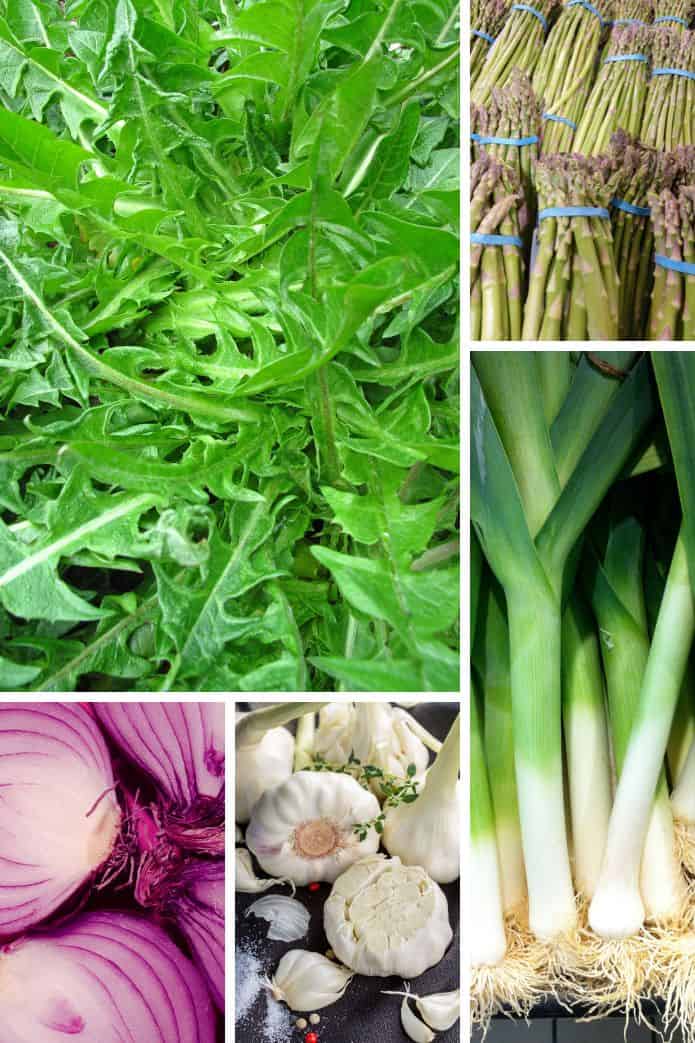
Prebiotics are the fiber that occurs in a variety of foods and feed the healthy bacteria already living in your gut.
Some foods high in prebiotics are:
- raw onions,
- garlic,
- asparagus,
- leeks,
- dandelion greens,
- jicama, and
- Jerusalem artichoke.
By regularly consuming prebiotics, you not only feed yourself, but you also feed trillions of tiny microscopic friends living in your gut, which are responsible for:
- making sure your digestion is happily humming along,
- keeping infections at bay,
- ensuring that your brain is firing on all cylinders and
- countless other wonders.
Read on to discover key differences between PREbiotics and PRObiotics, their benefits, and fifteen ways to add them to your diet.
- What are Prebiotics?
- Prebiotics Benefits
- How to Add Prebiotics to Your Diet
- Fermented Foods
- 1. Include Sauerkraut with Your Meals
- 2. Add a Crunchy Condiment: Fermented Asparagus
- 3. Flavor Dishes with Fermented Garlic Paste
- 4. Pasta with Dandelion Pumpkin Seed Pesto
- 5. Try Some Thyme for Leeks Sauerkraut or Relish
- 6. Start Your Day With A Breakfast Chutney
- 7. Top That Hamburger, Hot Dog, or Taco with Pickled Onions
- Munch on Prebiotic-Rich Raw Vegetables
- Use Prebiotic Vegetable Powders to Power Your Microbiome
- References on Prebiotics
- Fermented Foods
What are Prebiotics?
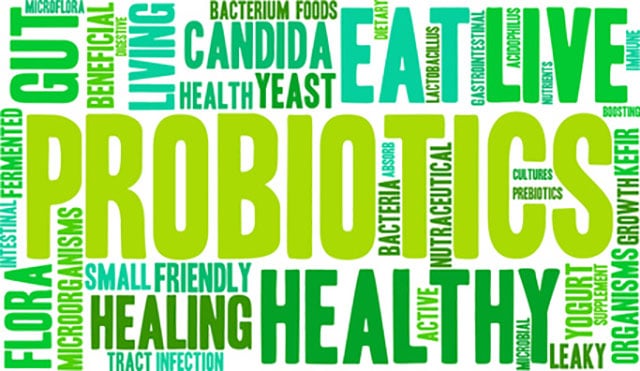
Prebiotics are the fiber that occurs in a variety of foods and feed the healthy bacteria already living in your gut.
Humans can’t digest this fiber, and it serves no nutritive purpose.
Our digestive enzymes and pancreas secretions can’t break down prebiotic fiber, but there is someone who can.
Our intestinal bacteria can ferment or metabolize this prebiotic fiber, which can, in turn, improve your health. This is the true benefit of consuming fiber.
“Prebiotics are, quite simply, indigestible food ingredients that stimulate the growth and maintenance of beneficial gut microbiota. I suppose “indigestible by humans” is more accurate because they are being digested – just not by our host digestive system (about 90% of prebiotic fiber makes it through the small intestine intact). Instead, it’s those oft-thankless, microbial workhorses of our colons doing all the work while we reap the benefits. They are getting free meals, so don’t feel too bad about putting them to work.”
– Mark Sisson, Mark’s Daily Apple
Prebiotics vs. Probiotics
In contrast, probiotics provide a direct infusion of healthy bacteria that were not there before and can help maintain robust gut health.
Probiotics are found in yogurt, kefir, sauerkraut, and other fermented foods.
Critical Differences Between Probiotics and Prebiotics
| PROBIOTICS | PREBIOTICS |
| Live microorganisms. | Non-living, non-digestible. |
| Bacteria or yeast cultures. | Fiber from plant sources. |
| Found in the stomach and small intestine. | Found in the stomach, small intestine, and large intestine. |
| Fight the bad microorganisms. | Feed the good microorganisms. |
Maintaining Good Gut Health
Over a century ago, Russian biologist Élie Mechnikov made a groundbreaking discovery about the connection between the bacteria in our bodies and our overall health.
Death begins in the colon. – Élie Mechnikov (1845-1916)
– Élie Mechnikov (1845-1916)
Prebiotics and probiotics work together to help maintain the health of your gut microbiome.
Following the launch of the Human Microbiome Project by the National Institutes of Health in 2008, scientists have made several key discoveries about the human microbiome, including:
- Diversity is Crucial: The project revealed that a rich and diverse microbiome is essential for good health. People with a more diverse set of bacteria in their gut tend to have lower rates of chronic diseases.
- Connection to Diseases: Researchers found links between the microbiome and various diseases, such as obesity, diabetes, and inflammatory bowel disease. Bacterial populations in the gut can influence the development or prevention of these conditions.
- Impact on Immune System: The microbiome plays a significant role in training and regulating the immune system. Changes in our gut bacteria can affect how our body responds to infections and may influence the effectiveness of vaccines.
Prebiotics Benefits

You often hear about the need to consume fiber, but it wasn’t until delving deeper into prebiotics that I was able to better understand the true benefits of the right type of fiber.
Inulin and oligofructose are two soluble fibers that occur together in foods rich in prebiotics and are most often listed on packaged food labels. They have a slightly sweet taste and are found naturally in most root vegetables.
Tiny amounts occur in onions or garlic, with much larger amounts in starchy roots such as chicory root or Jerusalem artichoke.
Prebiotics:
- Enhance the absorption of minerals in the body. Prebiotics have been shown to increase the uptake of magnesium, calcium, and possibly iron, leading to an increase in bone density, among other health benefits.
- Ferment in the gut to produce short-chain fatty acids (SCFA). SCFA helps regulate sodium and water absorption and nourish your intestinal lining to improve inflammatory bowel disease and Crohn’s disease.
- Increase the number of two types of bacteria in your gut microbiome: bifidobacteria and lactobacilli. A healthy population of bifidobacteria is associated with decreased illness and the suppression of potentially pathogenic and putrefactive bacteria in adults, reducing colon cancer risk.
Foods High in Prebiotics
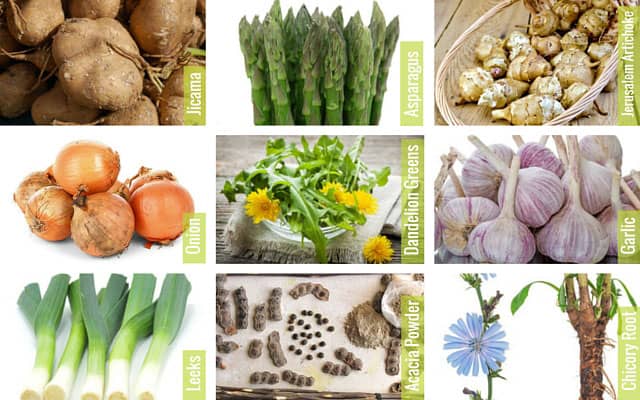
There are many prebiotic fibers, and scientists can’t agree on which ones are the most beneficial. They have agreed, however, that to officially call a fiber prebiotic, it must:
- Be non-digestible, which means it must pass through the stomach without being broken down by gastric acids or enzymes.
- Be able to be fermented or metabolized by intestinal bacteria.
- Confer health benefits. An increase in the activity and numbers of bifidobacteria and lactic acid bacteria is behind the increase in health conditions, such as improved digestion, enhanced mineral absorption, and strengthened immune systems.
Raw foods will have more prebiotic fibers than cooked.
The following table lists the top prebiotic foods and their fiber content.
Prebiotics Food List
The numbers for acacia powder and chicory root powder are high, but when using either of these root powders as a supplement, a typical dosage size is 1 tablespoon. For acacia powder, this equals 6 grams of fiber.
| 100 GRAMS, RAW | INULIN + OLIGOFRUCTOSE FIBER |
| Acacia Powder | 92.0 g |
| Chicory Root Powder | 64.5 g |
| Jerusalem Artichoke | 31.5 g |
| Dandelion Greens | 24.3 g |
| Garlic | 17.5 g |
| Leek | 11.7 g |
| Onion | 8.6 g |
| Jicama | 5.9 g |
| Asparagus | 5.0 g |
Foods high in prebiotics have been a part of our diets since prehistoric times. A typical hunter-gatherer consumed as much as 135 grams of inulin, a type of prebiotic fiber, each day.
Here are descriptions of the top prebiotic foods. Recipe ideas are in the following sections.
- Acacia powder is made by grinding up acacia gum, a natural gum made from the hardened sap of various species of the acacia tree. Acacia powder can be consumed on its own or as a supplement. It is important to consume the powder—as much as 1 tablespoon—with at least 8 ounces of fluids and drink enough water throughout the day to reduce the risk of constipation.
- Asparagus is a welcoming item at local farmers’ markets; it signals warmer days with summer just around the corner. Snack on them raw or learn to ferment them to garner the benefits of both prebiotics and probiotics.
- Chicory root has been a coffee substitute for generations, especially when coffee is unavailable. It is high in Vitamin C and has the highest concentration of inulin of any plant.
- Dandelion greens are “nasty” weeds that grow in lawns. They can be picked when the leaves are young and tender. Don’t pick from lawns treated with pesticides. Finely chop and add to your spring salad.
- Garlic has an endless list of health benefits, and being full of prebiotics is just one of them. Keep a jar of fermented garlic paste handy in your refrigerator for a quick addition to dishes.
- Jerusalem artichoke is a species of the sunflower family and is rich in potassium and iron. Peeled and chopped, they make a great addition to salads.
- Jicama is an edible root that resembles a turnip. It has thin brown skin and a crisp, white juicy flesh that’s mild in flavor. It tastes somewhat like a pear and is great to snack on.
- Leeks are a member of the onion family and have a sweet, delicate flavor. Use them like you would onions and garlic, adding them to sauteed greens or fermenting the younger, more tender ones into a delicious relish.
- Onions, both raw and cooked, are high in prebiotic fiber and add flavor to just about any dish. Without even realizing it, you probably have been eating this prebiotic daily.
Is Sauerkraut a Prebiotic?
Yes, sauerkraut can act as a prebiotic.
While it is better known for its probiotic qualities due to the beneficial bacteria produced during its fermentation process, sauerkraut also contains high amounts of fiber.
This fiber serves as a prebiotic, which feeds the good bacteria in the gut. The prebiotic effect comes from the undigested fibers in the cabbage and other ingredients that are used in making sauerkraut.
Therefore, consuming sauerkraut can support gut health by providing both probiotics and prebiotics.
Are Prebiotics for Everyone?
Perhaps not.
If you have SIBO (Small Intestinal Bacteria Overgrowth), Irritable Bowel Syndrome (IBS), or FODMAP intolerances, feeding more bacteria may make symptoms worse. The bacteria have to slowly be nurtured and rebalanced with a compromised gut.
Dosage
Most of us, including me, don’t eat enough prebiotics, which are important for our gut health. Although there’s no agreed-upon amount, it’s suggested to consume between 4 and 12 grams of prebiotics daily to help with digestion.
But don’t go overboard by introducing too many prebiotics at once. It is best to gradually add them to your diet.
Also, it’s important to have a variety of different foods in your diet. A diverse range of prebiotic and probiotic sources is key to maintaining good gut health. This variety helps nurture a wide range of beneficial bacteria in your gut.
Below are suggestions for various ways to incorporate prebiotics into your diet. When you put a meal together, aim to include both a prebiotic-rich food and a food containing probiotics.
How to Add Prebiotics to Your Diet
Fermented Foods
Fermented foods, such as sauerkraut, Kimchi, and fermented vegetables, are not only natural probiotics but, when made with foods rich in prebiotics, become a microbiome superfood.
1. Include Sauerkraut with Your Meals
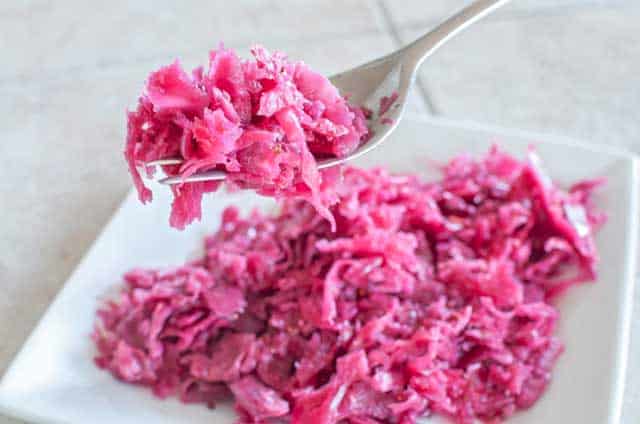
Prebiotic-rich onions and garlic are common ingredients in sauerkraut for a reason. Not only do they kick start the fermentation process, but they provide food for the bacteria that are working to preserve your sauerkraut.
My Sweet Garlic Sauerkraut recipe includes carrots for sweetness – great for first-time sauerkraut makers – and garlic, a prebiotic.
2. Add a Crunchy Condiment: Fermented Asparagus
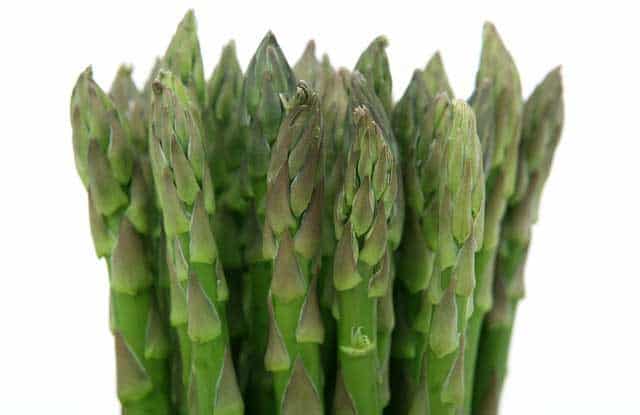
We know Spring has arrived when local asparagus is plentiful at the farmer’s markets. Try your hand at this simple ferment.
This recipe by Lorraine of Evermine Occasions makes use of a favorite fermentation book, Fermented Vegetables, and uses 2 tablespoons of brine from a batch of sauerkraut to provide a bit of liquid and jumpstart the fermentation process.
Asparagus Lactopickles to Bid Farewell to Spring
3. Flavor Dishes with Fermented Garlic Paste
I highly recommend adding relishes and pastes to your fermentation repertoire – yes, there’s more to life than sauerkraut – for they make meal preparation so much easier. This is a great one to start with. Sauteing greens? Stir in some fermented garlic paste. Easy Peasy.
4. Pasta with Dandelion Pumpkin Seed Pesto
“People can be protective about their pesto recipes and approaches. A little extra garlic or the special way they grind down the pesto? It’s the magic touch. This is largely because pesto is so adaptable: you can create a signature pesto using different nuts, greens, cheeses, and spices. When I found myself with a nice bunch of dandelion greens, I thought I’d try and make a pesto with them.”
5. Try Some Thyme for Leeks Sauerkraut or Relish
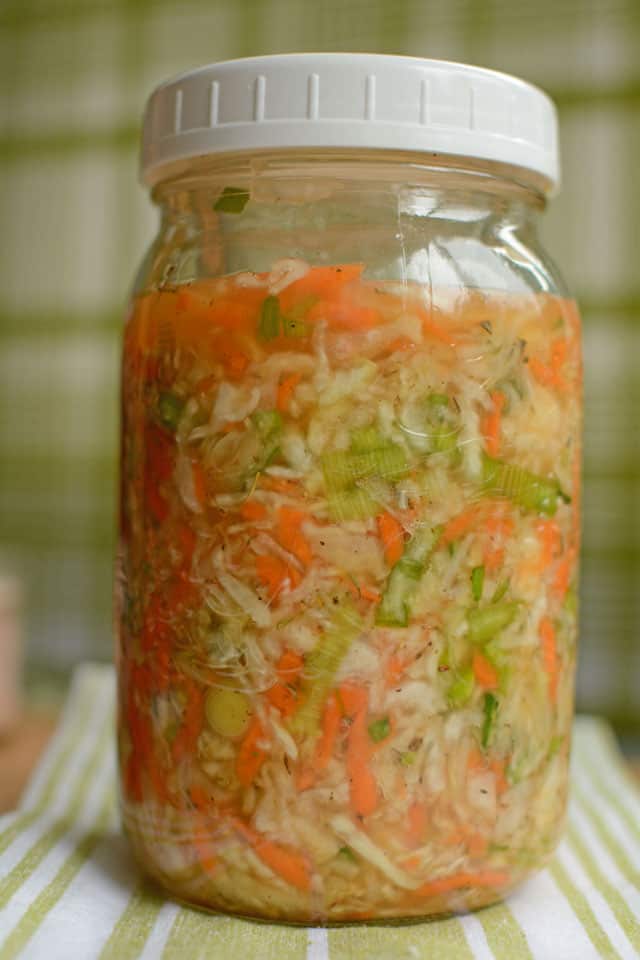
All right, this is a promo for my book. There are recipes for prebiotic-rich Thyme for Leeks Sauerkraut and Thyme for Leeks Relish in my book: Fermentation Made Easy! Mothwatering Sauerkraut
I love to spread the relish on a ham or turkey sandwich. Delish! The Thyme for Leeks Sauerkraut is great with poultry dishes.
6. Start Your Day With A Breakfast Chutney
The people behind the Perfect Pickler, one of the many jars designed for fermentation, put together this recipe to take advantage of the prebiotics found in jicama.
“Our recipe ingredient this month is jicama, one of my top stars in fresh brine fermenting. It is the tuberous root of a legume plant that has a crunchy, watery texture, like a cross between a water chestnut and an Asian pear. Its mild flavor is tinged with an ever-so-slight sweetness, courtesy of our favorite prebiotic fiber friend, inulin. It is a prebiotic that we are going to make into a specialty pickle: I call them prebiotic.”
Blueberry Chutney with Basil and Lime
7. Top That Hamburger, Hot Dog, or Taco with Pickled Onions
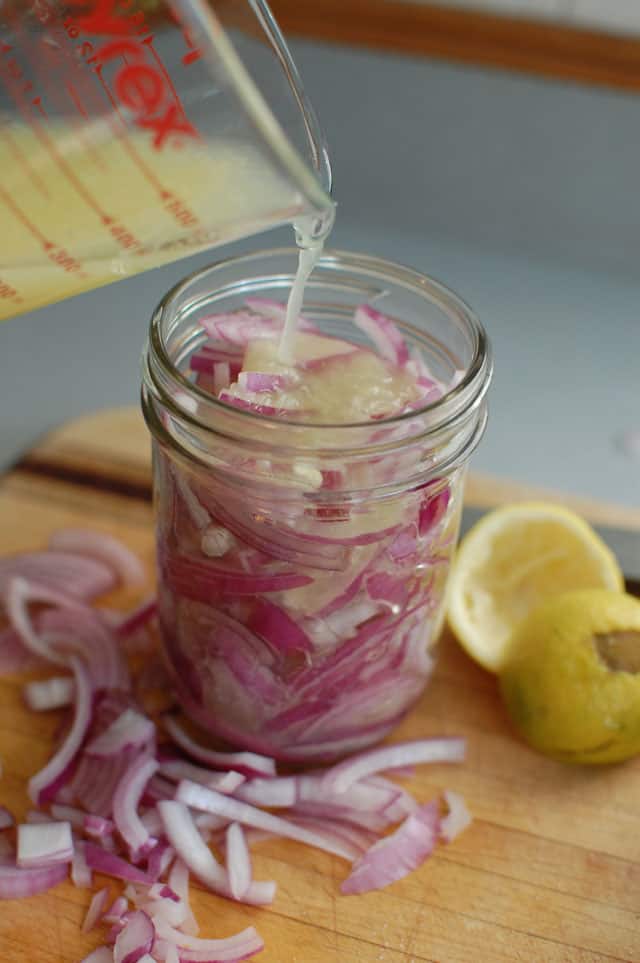
Danielle at Fermented Food Lab is always coming up with delicious fermented food recipes. I love to add lemon juice along with the brine.
“Recently I joined a CSA (community supported agriculture) where we get a big box of local, organic fruit and vegetables every week. I ended up getting a big bag of red onions and had no idea how my husband and I would eat them all before they went bad. So… of course, I decided to ferment them!! I’ve had pickled onions before, and they were very tasty. This uses the lacto-fermentation method which means fermenting in a salt brine. It’s super easy, basic, and only requires 3 ingredients.”
Munch on Prebiotic-Rich Raw Vegetables
8. Add Jicama and Jerusalem Artichokes to Your Next Vegetable Platter

Jicama sticks, and Jerusalem artichokes can easily be added to a vegetable platter or grated into salads. Make a creamy dip using yogurt or sour cream, and you’ve also added probiotics.
9. Toss Some Dandelion Greens on Your Spring Salad
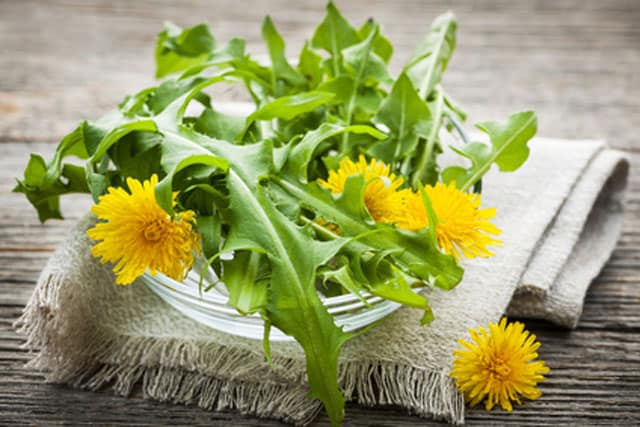
“In this springtime salad, dandelion greens are tossed with a warm roasted garlic dressing, tangy goat cheese, and toasted pine nuts for melt-in-your-mouth results.”
Warm Dandelion Greens with Roasted Garlic Dressing
10. Try Some Jicama Relish with Steak or Fish
You can’t beat this combo for a prebiotic punch: jicama, onion, green onions, and tomatoes.
11. Dip Chips Into Mango Avocado Salsa (with Jicama)
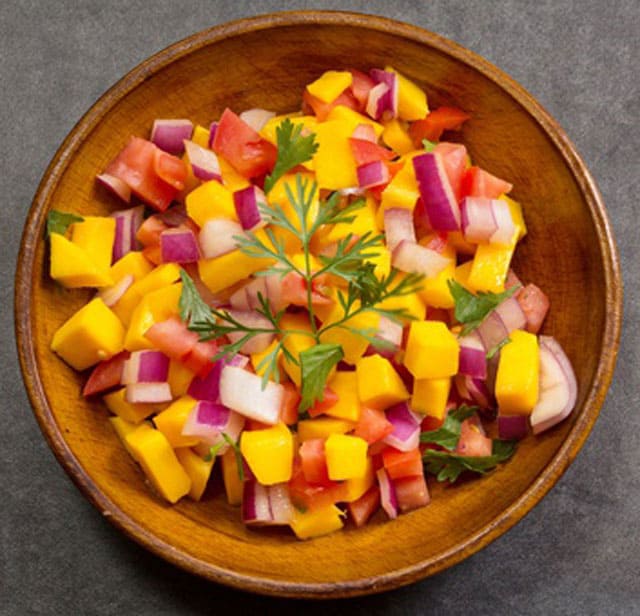
Everything you would want to know about jicama; the recipe is at the end.
12. Top Your Next Pizza with Caramelized Onions
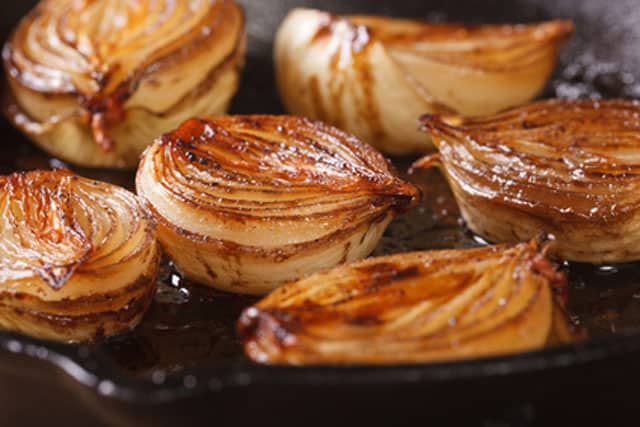
This may not be raw, but cooked onions are still high in prebiotic fibers. Simply Recipes gives you all the tips for perfect caramelized onions and suggests using them to top a steak, making onion soup, tarts, pizza, or onion. Hungry anyone?
“Caramelizing onions, by slowly cooking them in a little olive oil until they are richly browned, is a wonderful way to pull flavor out of the simplest of ingredients.”
Use Prebiotic Vegetable Powders to Power Your Microbiome
A whole new world has been opened for me with vegetable powders. They were not even on my radar until a holistic physician and curious thinker started this family business: Dr. Cowan’s Garden. From the website:
“A Vegetable Revolution with Deep Roots in the Ancient Past”
“Vegetables give you the power to live your life with vitality and freedom from disease. We dehydrate our organically grown vegetables with low heat to protect their vitality and store them as powders in Miron violet-glass jars. The secret to availing yourself of their disease-fighting nutrients is diversity: Eat small amounts of a wide variety of plants daily, especially perennial vegetables, rather than a large amount at one or two sittings. “
“Because perennial vegetables grow for years, they have wider-spreading and deeper-seeking roots that take up more nutrients in the soil. These plants have significantly higher levels of minerals, vitamins, and protein than annual vegetables. In addition to perennials, we powder the most nutritious annual vegetables available, such as kale, Swiss chard, tomatoes, and leeks.”
“Some of the healthiest people who ever lived—from Native Americans to traditional Africans—consumed such plant diversity. Our vegetable powders make this approach easy, delicious, and fun. You’ll love how their concentrated flavors enrich any dish.”
They not only make for a fun way to preserve the harvest but are also easy to use. They can be stirred into soups and stews, sprinkled on just about anything, blended into smoothies, or folded in rice. They are a great item to have in your bag when traveling, and for those dealing with picky eaters, they can be hidden in dishes.
13. Stir Leek Powder into Chicken Soup
The concentrated flavor of the leeks is a simple way to add richness – and prebiotics – to homemade soup.
DIY Prebiotic Powders
You may purchase leek powder here or follow the guidelines to dehydrate yourself.
- Use vegetables harvested at the peak of the season.
- Dehydrate within 48 hours of harvesting.
- Dehydrate on low heat (105 degrees) to retain the most vitamin and mineral content possible.
- Blanch greens before drying to release antinutrients.
- Bake pumpkins and squashes to maximize flavor and digestibility.
- Blanch or lightly steam carrots and beets.
- Leave tomatoes, leeks, and onions raw.
- Store away from light. The five-star method uses Miron violet-glass jars, but freezer bags should also work.
Step-by-step instructions on how to dehydrate leeks, though, to best preserve nutrients, I would dehydrate at 100 degrees:
Leek Powder, by Urban Nettle
14. Sip a Steaming Cup of Roasted Chicory Coffee

“It may have been made famous by New Orleans coffee shops and cafés, but roasted Chicory root beverages made from this blue-flowered perennial have been created for centuries.”
Mountain Rose Herbs, who sell the roasted root, share a few recipes:
Chicory Cafe au Lait and Coffee-Free Chicory Cacao Mocha.
15. Mix Acacia Powder with Fresh Juice to Increase Your Daily Fiber Intake
Acacia powder is a good source of fiber and is commonly taken to alleviate constipation, and the gut bugs love this stuff.
If you’re eating prebiotic foods, there’s probably no real need to supplement with a prebiotic powder, such as acacia powder. If you do, start small – 1 teaspoon – and work your way up. A 1-tablespoon dose supplies 6 grams of fiber. Mix with 8 ounces of fluid and drink plenty throughout the day.
References on Prebiotics
Fiber and Prebiotics: Mechanisms and Health Benefits
PubMed: Current Data with Inulin-type Fructans and Calcium, Targeting Bone Health in Adults
http://www.ncbi.nlm.nih.gov/pubmed/17951497
http://jn.nutrition.org/content/134/6/1523.full
http://www.ncbi.nlm.nih.gov/pmc/articles/PMC3705355/
Inulin: Friend or Foe
The Microbiome Diet, by Raphael Kellman, MD

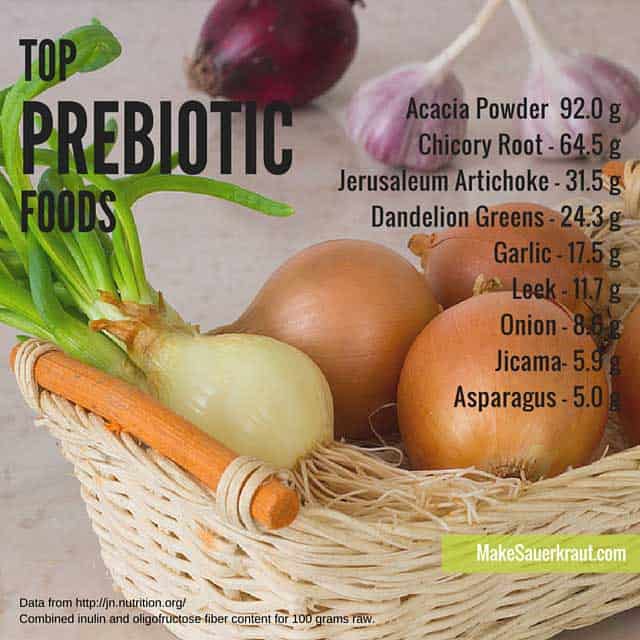

 This post may contain affiliate links which won’t change your price but will share some commission.
This post may contain affiliate links which won’t change your price but will share some commission.


